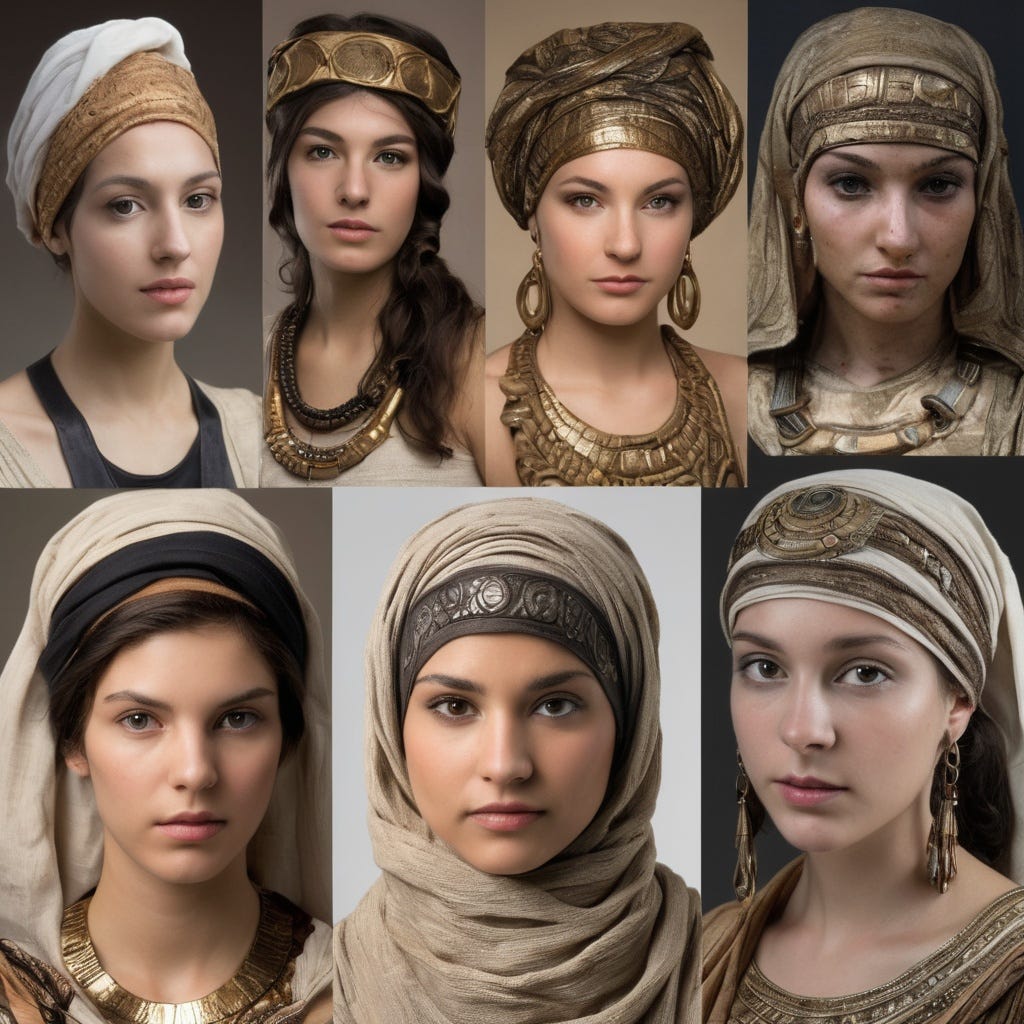Hi! I am Kardelen, and today I am exploring the history of hijab.
Humankind has always sought protection from the forces of nature through covering and clothing. The concept of clothing has evolved over time into various forms, created by humans themselves for different purposes. Sometimes, people wore animal skins to shield themselves from the cold, while at other times, they used thin linen fabrics to protect against the heat. Beyond these practical needs, clothing styles vary according to different cultures and religions; for some, clothing serves as a means of wealth, while for others, it is used for concealment.
Why are dress codes, regardless of culture or religion, especially imposed on women?
Dress codes tend to focus especially on women because clothing has long been tied to social control, gender roles, and power dynamics. Across many cultures and religions, women’s bodies and appearances have been viewed as symbols of morality, honor, and family reputation. Regulating how women dress becomes a way to enforce societal expectations about modesty, virtue, and femininity.
Historically, patriarchal societies often place greater emphasis on women’s behavior and appearance to maintain social order and control reproduction and sexuality. Restricting women’s dress is a means to control their visibility and autonomy in public spaces. It reflects deeper anxieties about women’s roles and challenges to traditional power structures.
Moreover, dress codes imposed on women can serve different purposes—sometimes to protect, sometimes to oppress, and sometimes to symbolize cultural or religious identity. But the common thread is that women’s bodies become battlegrounds for negotiating power, identity, and social norms.
So, from whom are men attempting to protect women by enforcing coverings or dress codes? - Other men.
The Sumerians (4000-2000 BC)
The Sumerians are known as the first historical civilization to use clothing as a marker of social status. This civilization had distinctive attire reserved for the nobility, and it was forbidden for slaves or lower-class individuals to dress like them—violations were punishable, sometimes even by death. This dress code is one of the earliest recorded examples of social restriction in written history. Even within the elite, there was a hierarchy: for example, those who were both elite and married could wear special headdresses and shawls. Similarly, soldiers were also granted the right to cover themselves. The common people, on the other hand, could only use simple fabrics for protection from the sun, and these fabrics were used to cover their shoulders and chests, not their heads.
In addition to these groups, there was another group of women entitled to cover their heads: women known as Harimtu or Naditu, who were dedicated to the goddess of love and fertility, Inanna.
The Babylonians-Akkadians (1800 BC)
In the ancient Babylonian civilization, the rules regarding veiling were explicitly defined. Married or widowed elite women were required to cover their heads. This was seen as a sign of their "modesty and respectability." Conversely, it was strictly forbidden for slaves and prostitutes to cover their heads.
The logic behind this restriction was clear: veiling was a privilege reserved for women under the protection of a man—typically a husband or father—while those outside of that patriarchal structure were denied the same markers of honor and autonomy.
This enforcement of veiling laws reveals a deeper cultural truth: veiling was less about modesty and more about visibility and control. It told the public who a woman "belonged to" and what her place in society was. In essence, veiling in Babylon was not merely religious or moral—it was legal, political, and class-based, reinforcing the strict hierarchies of Babylonian society.
First, it's important to mention—though not in great detail—a group of individuals who also existed in ancient civilizations: the sacred temple prostitutes (Nadītu, Ḫarimtu, and Qadištu). These women were seen as upper-class figures because, according to their religion, they engaged in their practices as a form of worship. As such, they were granted the right to veil and cover themselves.
In Judaism, Christianity, and Islam
Thousands of years after the earliest examples of veiling, a similar cultural tradition continued to exist within the Abrahamic religions.
"She took off her widow’s clothes, covered herself with a veil to disguise herself, and then sat down at the entrance to Enaim... When Judah saw her, he thought she was a prostitute, for she had covered her face."
— Genesis 38:14–15
"But every woman who prays or prophesies with her head uncovered dishonors her head— it is the same as having her head shaved. For if a woman does not cover her head, she might as well have her hair cut off."
— 1 Corinthians 11:5–6
“And tell the believing women to lower their gaze and guard their private parts and not expose their adornment except that which [necessarily] appears thereof and to draw their khimars over their bosoms…” — Surah An-Nur
During the time of the Israelites, the use of the veil changed—no longer was it worn by prostitutes, but rather by conservative women. This veiling tradition was specific to Jewish priestesses or women who were as devout as priestesses, even if they were not clergy themselves, and who either chose or were compelled to wear it. In early Jewish customs, there are no explicit instructions such as “cover your face” or “hide your hair.” Instead, the practice of veiling persisted as a continuation of traditions from ancient civilizations.
In Christianity, the situation is not much different. Although there were no strict veiling rules in the beginning, Roman women would simply wear a garment called a stola, held at the waist with a ribbon or belt, which emphasized their married and modest nature. When going outside, they would place a very thin piece of fabric over this garment, lightly covering their heads. However, this changed with the rise of the Papacy. The Vatican altered this practice to control women.
‘‘But every woman who prays or prophesies with her head uncovered dishonors her head—it is the same as having her head shaved. For if a woman does not cover her head, she might as well have her hair cut off. A man ought not to cover his head, since he is the image and glory of God; but woman is the glory of man.’’
‘‘For man was not made from woman, but woman from man. And man was not created for the woman, but woman for the man.’’
With the Roman Empire’s adoption of Christianity, the Vatican’s stance significantly influenced global attitudes toward women.
As in the Sumerians, pre-Islamic Arab women of high status wore a long dress called tawb, and these dresses were generally made of colorful fabrics. When going outside, they would lightly cover their heads with a veil called jilbab—which later evolved into the hijab—to protect themselves from the scorching sun. One of the most important details about Arab women was that they cared greatly about accessories. They wore anklets, bracelets, rings, and necklaces; in fact, in some tribes, cleavage was commonly displayed and emphasized with necklaces. All of this was a sign of their wealth and elite status. Ordinary people were not expected to cover themselves.
In the post-Islamic period, the concept of veiling first appears with Surah An-Nur. The critical point here is when and where this surah was revealed. Surah An-Nur was revealed in Medina around the first year of the Hijra. Following this verse, the Qur'an states that the best garment is the garment of piety. In verse 31 of Surah An-Nur, warnings are given regarding how women should dress, and this is where interpretations (tafsir) and historical context come into play.
In the early years of the Hijra, Medina’s population consisted of various Arab tribes and a considerable number of Jews. The city’s commerce was also controlled by these groups. As Arabs migrated from Mecca to Medina, tensions began to arise between them and the Jewish communities. Cases of theft and harassment against Muslim women increased, and confrontations escalated. It was during this period that Surah An-Nur was revealed, stating—much like in Jewish tradition—that women must cover themselves with clear and strict rulings. (Here, depending on your beliefs, there may be differences in interpretation. Whether you believe that the Qur'an was sent down from the heavens by God or that it was written by Muhammad, this part is striking either way.) While veiling and covering were once symbols of nobility, the Qur'an suddenly commands all Muslim women to cover themselves, to hide their gold and ornaments, and states that only their close male relatives may see them uncovered. This new order would both protect women from theft and harassment and attribute nobility to them.
Apart from these, there are no expressions in the Qur'an such as “cover yourself so that not a single strand of hair is visible.” In my opinion, all of these are traditions created to build male-dominated societies and to suppress the role of women in society. Everyone is free to dress as they wish; what truly matters is being able to control your thoughts.
That’s all for now! As always, readers’ opinions are welcome. Take care!
Kardelen







Thank you for this historical background! Human beings, as social beings, are obsessed with status and hierarchy of power. Clothing is very expressive of cultural values and ideas. I would like to hear your analysis of the use and significance of hijab in the collision between Islamic and Christian cultures, and to compare it with Western forms of covering, such as a Christian priest's robes.